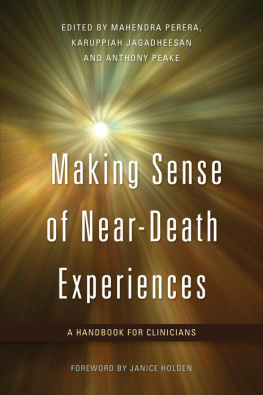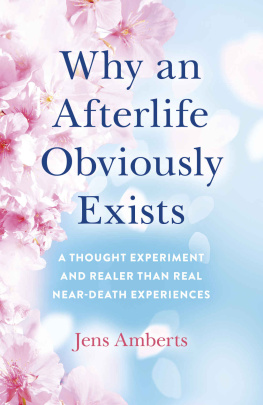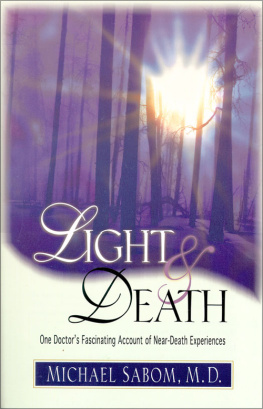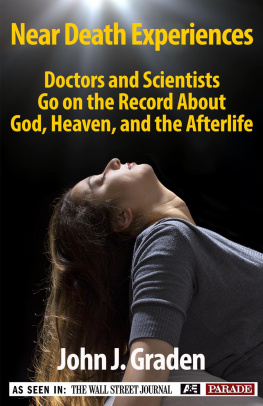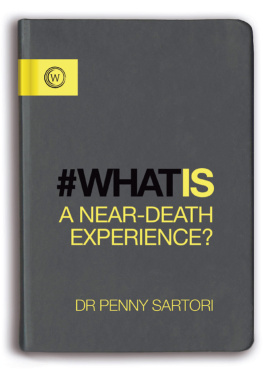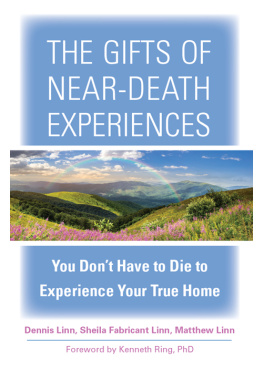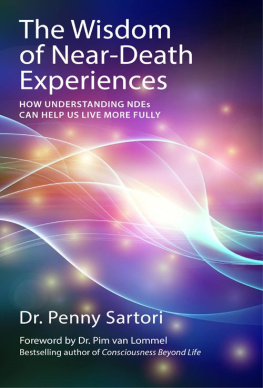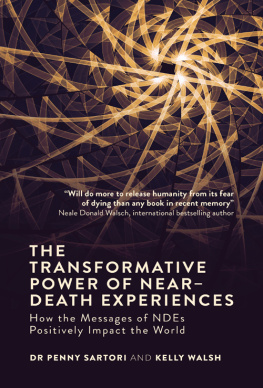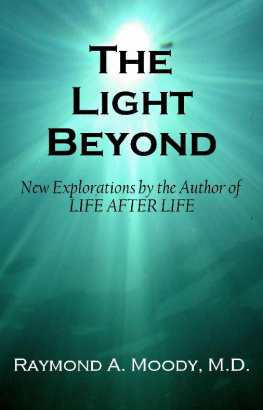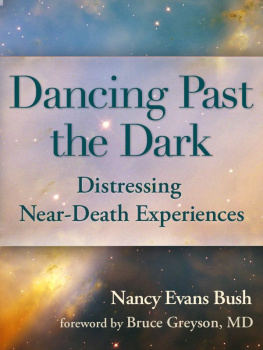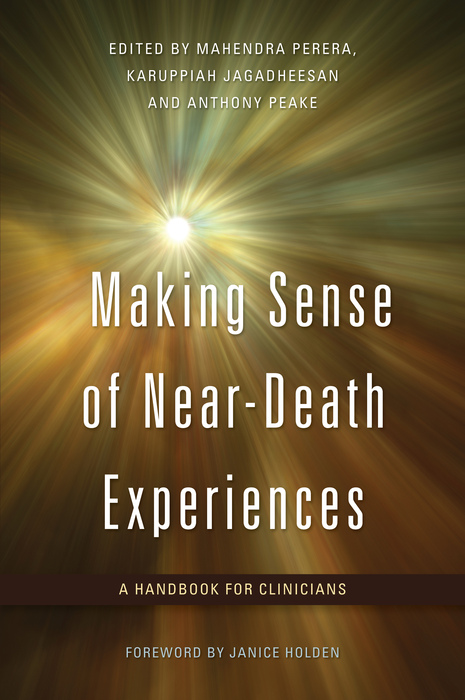Making Sense of Near-Death Experiences
A Handbook for Clinicians
Edited by Mahendra Perera, Karuppiah Jagadheesan and Anthony Peake
Foreword by Janice Holden
Jessica Kingsley Publishers
London and Philadelphia
The interview schedule and tape rating from Ring, 1980 on pp.138149 are reproduced with permission of Dr Kenneth Ring. These questionnaires appeared in Ring, K. (1980) Life at Death: A Scientific Investigation of the Near-Death Experience. New York: Coward, McCann & Geoghegan.
The NDE scale on pp.150152 is reproduced with permission of the International Association for Near-Death Studies. Reproduced with permission from Professor Bruce Greyson.
The NDE Questionnaire on p.153154 is reproduced with permission from the principal author, Dr Mahendra Perera, and the Editor-in-chief, Janice Holden, Journal of Near-Death Studies. The questionnaire appeared in Perera, M., Padmasekara, G. and Belanti, J. (2005) Prevalence of near-death experiences in Australia. Journal of Near-Death Studies 24, 109116.
Chapter 5 is adapted from Miner et al. and reproduced with permission.
First published in 2012
by Jessica Kingsley Publishers
116 Pentonville Road
London N1 9JB, UK
and
400 Market Street, Suite 400
Philadelphia, PA 19106, USA
www.jkp.com
Copyright Jessica Kingsley Publishers 2012
Foreword copyright Janice Holden 2012
All rights reserved. No part of this publication may be reproduced in any material form (including photocopying or storing it in any medium by electronic means and whether or not transiently or incidentally to some other use of this publication) without the written permission of the copyright owner except in accordance with the provisions of the Copyright, Designs and Patents Act 1988 or under the terms of a licence issued by the Copyright Licensing Agency Ltd, Saffron House, 610 Kirby Street, London EC1N 8TS. Applications for the copyright owners written permission to reproduce any part of this publication should be addressed to the publisher.
Warning: The doing of an unauthorised act in relation to a copyright work may result in both a civil claim for damages and criminal prosecution.
Library of Congress Cataloging in Publication Data
Making sense of near-death experiences : a handbook for clinicians / edited by
Mahendra Perera, Karuppiah Jagadheesan and Anthony Peake.
p. cm.
Includes bibliographical references and index.
ISBN 978-1-84905-149-1 (alk. paper)
1. Near-death experiences. 2. Near-death experiences--Psychological
aspects. I. Perera, Mahendra, 1951- II. Jagadheesan, Karuppiah, 1972- III.
Peake, Anthony.
BF1045.N4M35 2012
133.9013--dc23
2011021216
British Library Cataloguing in Publication Data
A CIP catalogue record for this book is available from the British Library
ISBN 978 1 84905 149 1
eISBN 978 0 85700 342 3
Converted to eBook by EasyEPUB
To those known and unknown who have gone before us and to all of us who will inevitably follow, for we are all one.
Foreword
In a recent study of 109 upper level undergraduate students at a large Southwestern US university (Holden, Oden, Kozlowski and Hayslip 2011), participants answered 20 questions about near-death experiences (NDEs). The questions addressed facts that 35 years of research on NDEs have established. Possible response to each question ranged from 1 (strongly disagree) to 4 (uncertain) to 7 (strongly agree). Participants average score was 4.74 somewhat better than an average of 4 if students had acknowledged uncertainty or were randomly guessing, but far below a perfect score of 7. Despite the fact that, to date, more than 65 NDE research studies have been published involving over 3500 near-death experiencers in the US, Europe, Asia, and Australia and focusing on the experience itself and/or its aftereffects (Holden, Greyson and James 2009), and despite increasing media coverage of NDEs and online availability of NDE narratives, widespread absence of information and misinformation about NDEs persist.
The nature of this need for accurate information begins with a most fundamental point: the difference between a near-death episode and a near-death experience. The confusion occurs when any close brush with death a near-death episode is referred to as a near-death experience which actually is a subjective experience reported by only about a quarter of all people who survive a close brush with death (Zingrone and Alvarado 2009). Near-death experiencers typically say that at the point that their bodies were near or actually in the first moments of death, their consciousness, now separated from their physical bodies, continued to experience and perceive the material world and/or a transmaterial domain of environments and entities. Many journalists unfortunately perpetuate the confusion by referring to any near-death episode as a near-death experience.
In the aftermath of NDEs, experiencers may turn to health care providers for understanding, information and assistance. However, a recent review of research indicated that medical and spiritual health care providers are only somewhat familiar with NDEs and that what they do know seems only partially accurate despite positive attitudes toward NDEs and a desire to learn more about them (Foster, James and Holden 2009, p. 256).
Undergraduates, journalists and health care providers all point to the need for resources that familiarize and inform about NDEs. Making Sense of Near-Death Experiences offers readers just such a resource. Chapter authors reflect an international span, representing the US, Europe, and Asia. With works by veteran researchers in the field such as mental health therapist Cherie Sutherland, cardiologist Pim van Lommel, and neuropsychiatrist Peter Fenwick, along with NDE scholars from the UK and India, readers hear many voices and are exposed to many perspectives on NDEs. Readers encounter both already-known information from, and also future-projected directions in, NDE investigation through chapters that range from general overviews to specific technical treatises. For readers whose interest is piqued to pursue further inquiry through primary and other quality secondary sources, Making Sense of Near-Death Experiences points such readers to many of those sources.
Even as a veteran near-death researcher, I found Making Sense of Near-Death Experiences an interesting and provocative read. I believe readers will come away from this book with not only an understanding of diverse viewpoints about NDEs but also an awareness of the complexity of the field of near-death studies and an appreciation for the value of continued research in the field. Thus the title Making Sense of Near-Death Experiences indicates appropriately not only a review of what is already known of NDEs so far but also an endeavor for humanity to continue pursuing into the future.
Janice Holden, Ed.D., LPC-S, LMFT, NCC
Professor, Counseling Program Chair, Department of Counseling and Higher Education, University of North Texas, USA
Acknowledgements
We are sincerely grateful to all of those who made this venture a success by contributing in many different ways, including the authors who gave tirelessly of their time and the publication staff at Jessica Kingsley Publishers. A special word of thanks to Caroline Walton of JKP who responded to our many questions in a timely manner.

